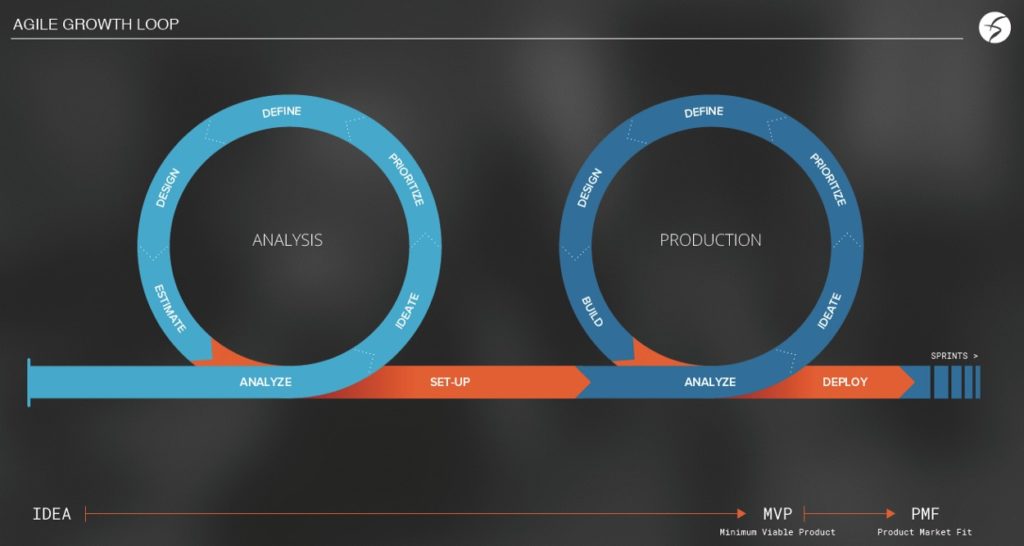Extreme uncertainty. Constant change. Ever growing complexity. Inadaptation of the waterfall approach. You know something has to change.
You have heard about digital transformation, but you are not sure where and how to start. Agility is probably the answer.
Here are 8 foundational insights to implement it in your organization.
#1. Recognize That You Don’t Have All the Answers.
We just don’t know what the future is going to look like, so we have to admit this simple fact. Making sure that your team is aligned and comfortable with not knowing most of the answers is probably the most important mind shift your organization needs to make.
It is OK to not know, as long as you put in place a solid process to manage uncertainty and accountability.
#2. Plan Agile.
No plan survives first contact with the enemy, explained the young Prussian commander Helmuth van Moltke, in 1880. Traditional business planning has become less and less effective: in an ever changing world where complexity is always growing, so is uncertainty.
Businesses need to be fully agile to adapt constantly and deliver results in tune with markets. Iterative planning, or Agility, is one way to do this.
Planning, executing, measuring, and pivoting based on real time results are the key steps to better performance.
Nothing is certain, and nothing ever stays the same. Planning for your business should be no different.
#3. Measure Progress With Hypothesis.
It is very hard to know when an idea is good or bad. I have seen ideas with great potential be dismissed by a VP in seconds. Don’t dismiss or cling to ideas without data to back up your response. Your team needs to act scientific.
Outline hypothesis. Break them down in small tests (because you need to learn fast). Make sure you can measure the results. Get rid of any that you can’t.
#4. Adopt continuous delivery.
Research, ideate, plan/roadmap, form your team, execute, then market. This is the way most business executives think, and the reason why most projects do not finish on time or on budget. Yet the most productive organizations think agile: they build, test, measure, learn, and change as they move through developing a product or project at every step.
Continuous delivery always beats waterfall.
#5. Win with continuous improvement.
Walk from MVP towards Product Market Fit using MVT (Minimum Viable Test). It is crucial to quickly launch the simplest version of a company’s product to get user feedback before changing, improving, and launching the next version of a service, product or other offering.
There are no better data points towards improvement than what users say about their experience with a product, and what they want to see out of a product.
Selling means listening: listen to customers, and both sales and products should improve.
#6. Develop with cross-functional teams.
When working on a product or project, build small and cross-functional teams in a flattened team structure. Every team member must be able to take and share equal responsibility in the area of the product their specialty touches. Leaders will emerge based on needs at hand, in real time.
Trust is vital here: flat, leaderless, cross-functional groups with high-performing team members are environments that allow people to work on projects and/or products in ways that complement their specialty and eliminate silos.
#7. Listen to your customers.
A business should constantly communicate with its prospects and customers to improve its projects, products, and/or services. Without customer input, teams and organizations fly blindly, and often crash.
Yet Agility, an iterative process characterized by short sprints, allows your organization to constantly test hypotheses, and fuel product development with data.
You don’t need expert feedback. You need customer feedback.
#8. Listen to the data.
Self-honest, agile planning by flat teams using hypothesis and customer feedback to fuel continuous delivery and improvement amounts to agility. Assuming an expert, an executive, or teams already know or can predict answers to complex problems before trying to solve them is at best puzzling.
Agile team dynamics produces and deploys projects that are far more informed and adaptive than traditional business planning and waterfall delivery are capable of.
Using agility’s data-driven approach to these processes allows companies to realize digital transformation, using customer-generated data to produce more and better results for each product, project, and service a company releases. Hence, more business leaders and new businesses alike are embracing Agility.
As a vertical integration platform, Pentalog provides an Agile approach to full-stack digital product development designed to help our clients craft sustainable, performance-driven strategies for healthy business growth. Reach out to learn more about how to apply the Agile growth loop to your business.
Read more:
Gathering Reliable Data to Appreciate Agile Performance, from Developers to the CEO
Extend the Life of your Digital Assets: Introduce UI/UX into Maintenance Sprints











